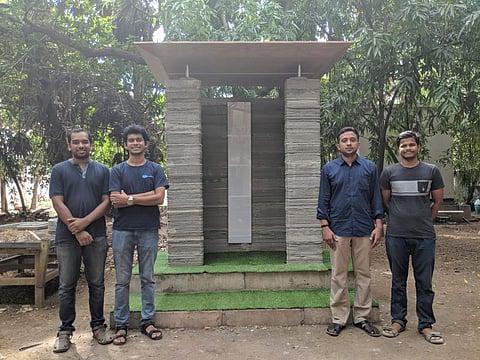

When you think 3D Printing, the image that springs to mind is a device that takes several hours to print a small object. So when IIT Madras told us that they planned to 3D print a house, we wondered how many decades that was going to take. Truth is, they tell us that it'll probably end up being faster than a normal brick-and-mortar construction once they're done with their research. IIT Madras' Civil Engineering Department has tied up with Tvasta, a start-up established by four of their alumni to create the IIT Madras Printability Lab to fast-track this project.
But before that, let's get down to the basics. How do you 3D print a house? Block by concrete block, of course. Vidyashankar C, one of the four co-founders of Tvasta, explains that 3D printing concrete is a whole other ballgame that's way faster, "It is true that most 3D printers take a lot of time to print components like plastic and metal, but the rate of concrete printing is much faster."
Incidentally, though they didn't start off wanting to print houses, the co-founders were very excited about 3D printing as a concept.
Team Tvasta has built a structure in Chennai to show us how a 3D printed house will feel and look. "Our prototyping and test runs have been extremely extensive. We have been running trials every single day for the past two years and what has come is the result of extensive trial and development," he explains of a journey that has only just begun. With 3D printed concrete, buildings or structures are fundamentally built layer-by-layer as compared to conventional building methods, where metal parts are cast or machined, which makes it easier, faster and (inevitably) cheaper, "We know for a fact that buildings are best suited for 3D printing or additive manufacturing (as it is known formally) than most other objects that we see around ourselves," he reckons.
Cheaper? How is that even possible, we wonder, on behalf of civil engineers everywhere. He responds quickly, "As this is new technology, it is difficult for us to give you an accurate estimate of the cost involved. We are intending to launch a pilot project to build demo houses around the country. This will enable us to estimate the cost of construction accurately, building materials and logistics. But, we can be assured that at this point in time, the cost of construction via 3D printing will be more expensive as compared to conventional construction. As per our calculations, in a few years when the economies of scale favour us, we will be on par with conventional construction companies."
With an aim to make the technology market-ready and market-sensible, the team is hopeful that this will contribute towards helping the 11 million or so homeless people in the country, find a roof to call their own, “In the near future we want to share our technology with construction agencies so as to make urban quality-construction available to rural areas across our country," he states.
